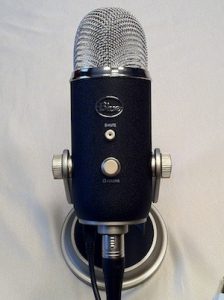 There is one limitation common to USB mics that has me reaching for an old fashioned XLR microphone: the sample rate. Blue’s original Yeti records at 16bit/48 kHz. That is ideal for streaming content on the Web via podcasting or YouTube videos. For music or more demanding applications it falls short. Anyone making records in 16-bit isn’t thinking ahead. Inevitably high-res, 24-bit digital downloads will be the norm in the future.
There is one limitation common to USB mics that has me reaching for an old fashioned XLR microphone: the sample rate. Blue’s original Yeti records at 16bit/48 kHz. That is ideal for streaming content on the Web via podcasting or YouTube videos. For music or more demanding applications it falls short. Anyone making records in 16-bit isn’t thinking ahead. Inevitably high-res, 24-bit digital downloads will be the norm in the future.
This is a trailblazing microphone. First off, it is the only USB mic so far that can record 24-bit audio. Secondly, it is the first mic I’ve seen that accepts both USB and XLR connections. For people on the move that flexibility can be a lifesaver in a pinch, especially when working with others. Plenty of pro audio engineers don’t have experience with USB mics. These types will be at home with industry standard XLR connections and analog post-processing.
The most obvious upgrade to the Pro model is the sexy casing. The black textured body adds an element of class that was missing from the modest original. It weighs in at around 3 lbs and stands nearly a foot tall. The Yeti was already a beast of a USB mic; this thing is a monster.
At the bottom of the unit there is a XLR input positioned above a treaded input for stand mounting. To the left is a mini-USB port and to the right there is a headphone input.
The 1/8” headphone jack is of course useful for people that don’t have the luxury of a professional, full-duplex sound card. You’ll be able to take advantage of low-latency monitoring thanks to the internal audio interface.
Like the original Yeti, there is an array of three 14mm condenser capsules under the grill. By switching on and off any combination of these capsules the Yeti Pro offers your choice of four pickup patterns: stereo, cardioid, omni, and bidirectional. In my previous review for the Yeti I broke down the uses for each of these patterns. You can read it here.
So, how does the Yeti Pro sound? Audio is off the scale awesome for a USB microphone. Right off the bat it has the advantage of being the only 24-bit USB mic (presently) on the market. The jump from 16 to 24 bit makes everything sound richer and smoother. High end especially is more detailed and pleasant. In regular circumstances I wouldn’t use a USB mic as an overhead on drums. If I had to however, this is the USB mic I’d choose. You can’t quite capture the sparkle in the cymbals in anything less than 24-bit.
Controls and switches are identical to the previous model. You have a nice big volume knob with a mute button above it in front. In the rear there is a switch that allows you to switch between recording patterns. Power is provided either via USB or 48v phantom power, depending on how you choose to connect the Yeti Pro.
Review Verdict
USB mics certainly blow away that Plantronics-style headset mic. Still, it isn’t honest to call any USB powered offering I’ve heard yet a professional mic. This is the best “prosumer” USB microphone yet. The addition of XLR is handy if you don’t own several other mics (or only want to bring one microphone to the gig).
Podcasters and musicians that don’t have a fancy audio interface (soundcard) and want to experience 24-bit recording have no better options. This puppy is it!

